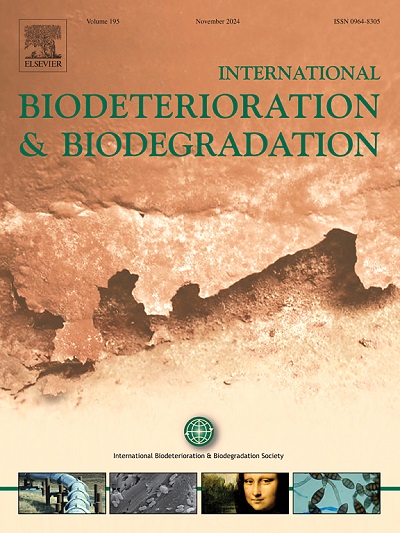自养条件下橡胶红球菌lz1的CO2代谢及能量获取机制
IF 4.1
2区 环境科学与生态学
Q2 BIOTECHNOLOGY & APPLIED MICROBIOLOGY
International Biodeterioration & Biodegradation
Pub Date : 2025-06-13
DOI:10.1016/j.ibiod.2025.106151
引用次数: 0
摘要
本研究从环氧丙烷皂化废水的活性污泥中分离出一株能自养生长的橡胶红球菌lz1。基因组学和转录组学分析显示缺乏典型的碳固定途径,但确定了一个完整的[NiFe]-氢化酶成熟系统。值得注意的是,氢化酶亚基(hyaA和hyaB)在自养条件下显著上调,表明微量大气H2是电子供体。该菌株通过CO2→甲酸→甲醛→CH2-THF→丝氨酸→丙酮酸盐的非典型C1同化途径来固定CO2。参与糖异生、TCA循环和丙酮酸/丙酸代谢的基因也被上调,表明一个协调的代谢网络支持碳通量和能量稳态。这些发现为非经典自养细菌的其他二氧化碳固定策略提供了新的见解。本文章由计算机程序翻译,如有差异,请以英文原文为准。
CO2 metabolism and energy acquisition mechanisms of Rhodococcus ruber lz1 under autotrophic conditions
In this study, a strain capable of autotrophic growth, Rhodococcus ruber lz1, was isolated from the activated sludge of propylene oxide saponification wastewater. Genomic and transcriptomic analyses revealed the absence of canonical carbon fixation pathways, but identified a complete [NiFe]-hydrogenase maturation system. Notably, hydrogenase subunits (hyaA and hyaB) were significantly upregulated under autotrophic conditions, suggesting the use of trace atmospheric H2 as an electron donor. The strain is proposed to fix CO2 via a non-canonical C1 assimilation pathway proceeding through CO2 → formate → formaldehyde → CH2-THF → serine → pyruvate. Genes involved in gluconeogenesis, the TCA cycle, and pyruvate/propionate metabolism were also upregulated, indicating a coordinated metabolic network supporting carbon flux and energy homeostasis. These findings offer new insights into alternative CO2 fixation strategies in non-classical autotrophic bacteria.
求助全文
通过发布文献求助,成功后即可免费获取论文全文。
去求助
来源期刊
CiteScore
9.60
自引率
10.40%
发文量
107
审稿时长
21 days
期刊介绍:
International Biodeterioration and Biodegradation publishes original research papers and reviews on the biological causes of deterioration or degradation.

 求助内容:
求助内容: 应助结果提醒方式:
应助结果提醒方式:


